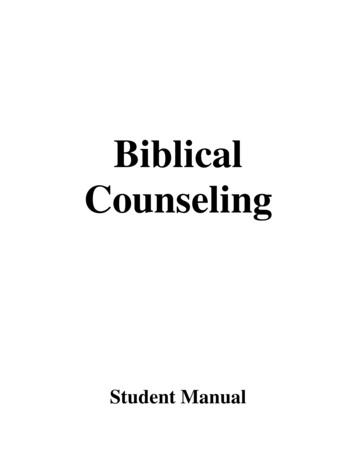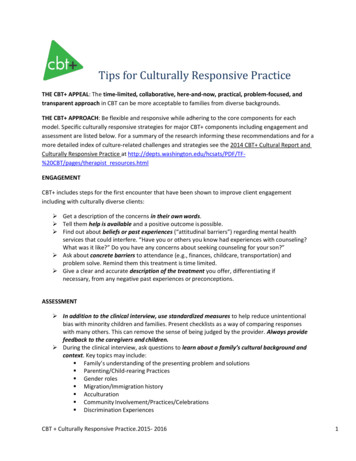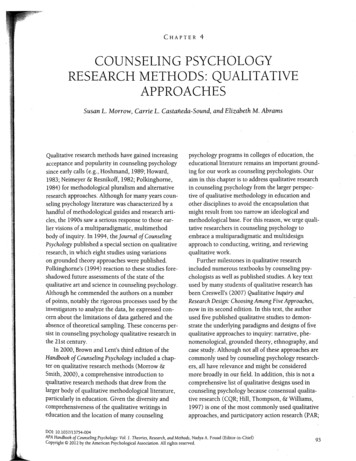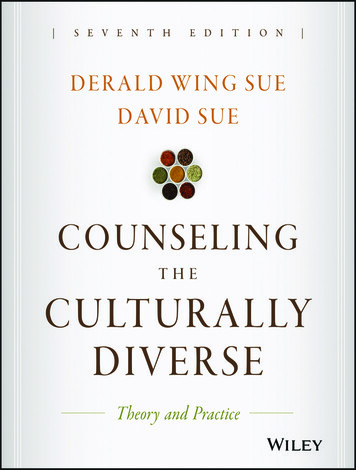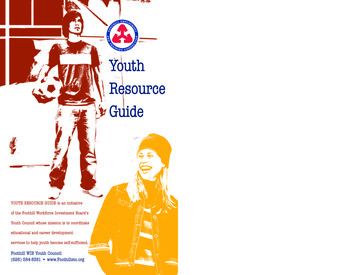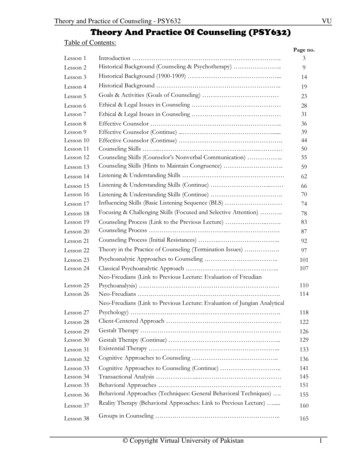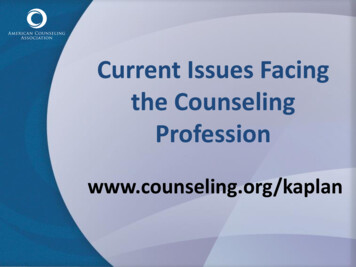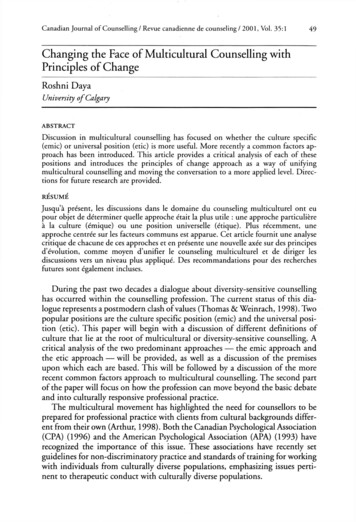
Transcription
Counseling theCulturally DiverseTheory and PracticeFifth EditionDerald Wing SueDavid SueJOHN WILEY & SONS, INC.
Counseling theCulturally Diverse
Counseling theCulturally DiverseTheory and PracticeFifth EditionDerald Wing SueDavid SueJOHN WILEY & SONS, INC.
Copyright 2008 by John Wiley & Sons, Inc. All rights reserved.Published by John Wiley & Sons, Inc., Hoboken, New Jersey.Published simultaneously in Canada.No part of this publication may be reproduced, stored in a retrieval system, or transmittedin any form or by any means, electronic, mechanical, photocopying, recording, scanning,or otherwise, except as permitted under Section 107 or 108 of the 1976 United StatesCopyright Act, without either the prior written permission of the Publisher, or authorizationthrough payment of the appropriate per-copy fee to the Copyright Clearance Center, Inc.,222 Rosewood Drive, Danvers, MA 01923, (978) 750-8400, fax (978) 646-8600, or on the webat www.copyright.com. Requests to the Publisher for permission should be addressed to thePermissions Department, John Wiley & Sons, Inc., 111 River Street, Hoboken, NJ 07030,(201) 748-6011, fax (201) 748-6008, or online at http://www.wiley.com/go/permissions.Limit of Liability/Disclaimer of Warranty: While the publisher and author have used their bestefforts in preparing this book, they make no representations or warranties with respect to theaccuracy or completeness of the contents of this book and specifically disclaim any impliedwarranties of merchantability or fitness for a particular purpose. No warranty may be createdor extended by sales representatives or written sales materials. The advice and strategiescontained herein may not be suitable for your situation. You should consult with a professionalwhere appropriate. Neither the publisher nor author shall be liable for any loss of profit or anyother commercial damages, including but not limited to special, incidental, consequential, orother damages.This publication is designed to provide accurate and authoritative information in regard to thesubject matter covered. It is sold with the understanding that the publisher is not engaged inrendering professional services. If legal, accounting, medical, psychological or any other expertassistance is required, the services of a competent professional person should be sought.Designations used by companies to distinguish their products are often claimed as trademarks.In all instances where John Wiley & Sons, Inc. is aware of a claim, the product names appear ininitial capital or all capital letters. Readers, however, should contact the appropriate companiesfor more complete information regarding trademarks and registration.For general information on our other products and services please contact our Customer CareDepartment within the United States at (800) 762-2974, outside the United States at(317) 572-3993 or fax (317) 572-4002.Wiley also publishes its books in a variety of electronic formats. Some content that appears inprint may not be available in electronic books. For more information about Wiley products,visit our Web site at www.wiley.com.Library of Congress Cataloging-in-Publication DataSue, Derald Wing.Counseling the culturally diverse : theory and practice / Derald Wing Sue, David Sue. —5th ed.p. cm.Includes index.ISBN 978-0-470-08632-2 (cloth)1. Cross-cultural counseling. I. Sue, David. II. Title.BF637.C6S85 2007158 .3—dc222007002547Printed in the United States of America.10 9 8 7 6 5 4 3 2 1
CONTENTSPrefacexixSection IThe Multiple Dimensions of MulticulturalCounseling and TherapyPart IThe Affective and Conceptual Dimensions ofMulticultural Counseling/Therapy3Chapter 1The Multicultural Journey to Cultural Competence:Personal Narratives5My Personal and Professional Journey as a WhitePerson: Reactions to Counseling the CulturallyDiverse: Theory and Practice—Mark S. KiselicaMy Personal and Professional Journey as a Personof Color: The Heart and Soul of Counseling theCulturally Diverse—Derald Wing Sue616Being Chinese American in a Monocultural Society 18The College and Graduate School Years 20First Job—A Counseling Psychologist 21Going into Academia 22Work on Multicultural Counseling and Therapy 23Expanding Social Justice Horizons 24Implications for Clinical Practice26Chapter 2The Superordinate Nature of MulticulturalCounseling and Therapy29Theme One: Cultural Universality versusCultural RelativismTheme Two: The Emotional Consequences of “Race”3132v
viContentsTheme Three: The Inclusive or Exclusive Nature of MulticulturalismTheme Four: The Sociopolitical Nature of Counseling/TherapyTheme Five: The Nature of Multicultural Counseling CompetenceA Tripartite Framework for Understanding the Multiple Dimensionsof IdentityIndividual and Universal Biases in Psychology and Mental HealthThe Impact of Group Identities on Counseling and PsychotherapyWhat Is Multicultural Counseling/Therapy?What Is Cultural Competence?3334353640414243Competency One: Therapist Awareness of One’s Own Assumptions, Values,and Biases 44Competency Two: Understanding the Worldview of CulturallyDiverse Clients 44Competency Three: Developing Appropriate Intervention Strategiesand Techniques 45Multidimensional Model of Cultural Competence in CounselingImplications for Clinical Practice4851Part IIThe Political Dimensions of Mental Health Practice53Chapter 3The Politics of Counseling and Psychotherapy55The Diversification of the United States59The Graying of the Workforce and Society 59The Feminization of the Workforce and Society 60The Changing Complexion of the Workforce and Society61The Education and Training of Mental Health ProfessionalsDefinitions of Mental Health 66Curriculum and Training Deficiencies70Counseling and Mental Health LiteratureMinorities and Pathology647171Relevance of ResearchImplications for Clinical Practice7576
ContentsviiChapter 4Sociopolitical Implications of Oppression: Trust and Mistrustin Counseling/Therapy79Effects of Historical and Current Oppression84Ethnocentric Monoculturalism 84Historical Manifestations of Ethnocentric MonoculturalismTherapeutic Impact of Ethnocentric Monoculturalism 9188Credibility and Attractiveness in Multicultural CounselingCounseling as Interpersonal InfluencePsychological Sets of Clients 95Therapist Credibility 989394Implications for Clinical Practice102Chapter 5Racial, Gender, and Sexual Orientation Microaggressions:Implications for Counseling and Psychotherapy105By Derald Wing Sue & Christina M. CapodilupoRacism, Sexism, and Heterosexism107The Evolution of Racism, Sexism, and Heterosexism: MicroaggressionsThe Dynamics and Dilemmas of Microaggressions 112Therapeutic Implications 121110Implications for Clinical Practice124Part IIIThe Practice Dimensions of Multicultural Counseling/Therapy131Chapter 6Barriers to Multicultural Counseling and Therapy133Characteristics of Counseling/TherapyGeneric Characteristics of Counseling/TherapyCulture-Bound Values137137140Focus on the Individual 141Verbal/Emotional/Behavioral Expressiveness142
viiiContentsInsight 143Self-Disclosure (Openness and Intimacy) 145Scientific Empiricism 146Distinctions between Mental and Physical FunctioningAmbiguity 147Patterns of Communication 147146Class-Bound ValuesLanguage BarriersGeneralizations and Stereotypes: Some CautionsImplications for Clinical Practice148151153154Chapter 7Culturally Appropriate Intervention Strategies157Communication Styles160Nonverbal Communication162Sociopolitical Facets of Nonverbal CommunicationNonverbals as Reflections of Bias 170Nonverbals as Triggers to Biases and Fears169172Counseling and Therapy as Communication Style176Differential Skills in Multicultural Counseling/Therapy 177Implications for Multicultural Counseling/Therapy 178Implications for Clinical Practice181Chapter 8Multicultural Family Counseling and Therapy183Family Systems Counseling and TherapyIssues in Working with Ethnic Minority Families189190Ethnic Minority Reality 190Conflicting Value Systems 191Biculturalism 192Ethnic Differences in Minority StatusEthnicity and Language 195Ethnicity and Social Class 196192
ContentsMulticultural Family Counseling/Therapy: A Conceptual Modelix196People-Nature Relationship 197Time Dimension 199Relational Dimension 201Activity Dimension 203Nature of People Dimension 204Implications for Clinical Practice205Chapter 9Non-Western Indigenous Methods of Healing:Implications for Counseling and Therapy209The Legitimacy of Culture-Bound Syndromes: Nightmare Deaths and theHmong Sudden Death Phenomenon211Causation and Spirit Possession 214The Shaman as Therapist: Commonalities 215A Case of Child Abuse? 216The Principles of Indigenous Healing 219Holistic Outlook, Interconnectedness, and HarmonyBelief in Metaphysical Levels of Existence 223Spirituality in Life and the Cosmos 225222Implications for Clinical Practice228Part IVRacial/Cultural Identity Development in MulticulturalCounseling and Therapy231Chapter 10Racial/Cultural Identity Development in People of Color:Therapeutic Implications233Racial/Cultural Identity Development Models235Black Identity Development Models 236Asian American Development Models 239Latino/Hispanic American Identity Development Models240
xContentsA Racial/Cultural Identity Development Model242Conformity Stage 242Dissonance Stage 246Resistance and Immersion Stage 248Introspection Stage 249Integrative Awareness Stage 251Therapeutic Implications of the R/CID Model252Conformity Stage: Therapeutic Implications 253Dissonance Stage: Therapeutic Implications 254Resistance and Immersion Stage: Therapeutic Implications 255Introspection Stage: Therapeutic Implications 256Integrative Awareness Stage: Therapeutic Implications 256Implications for Clinical Practice257Chapter 11White Racial Identity Development: Therapeutic Implications259What Does It Mean to Be White?The Invisible Whiteness of BeingUnderstanding the Dynamics of WhitenessModels of White Racial Identity Development259262263265The Hardiman White Racial Identity Development Model 266The Helms White Racial Identity Development Model 269The Process of White Racial Identity Development: A Descriptive ModelImplications for Clinical Practice276282Part VSocial Justice Dimensions in Counseling/Therapy285Chapter 12Social Justice Counseling/Therapy287Social Justice Counseling292Understanding Individual and Systemic WorldviewsLocus of Control293294
ContentsLocus of ResponsibilityFormation of Worldviewsxi296297Internal Locus of Control (IC)–Internal Locus of Responsibility (IR) 298External Locus of Control (EC)–Internal Locus of Responsibility (IR) 300External Locus of Control (EC)–External Locus of Responsibility (ER) 302Internal Locus of Control (IC)–External Locus of Responsibility (ER) 303Multicultural Organizational Development (Meso Level)Culturally Competent Mental Health Agencies305306Systemic Change (Macro Level)309Antiracism as a Social Justice Agenda 310Social Justice Requires Counseling Advocacy Roles311Section IIMulticultural Counseling and Specific PopulationsPart VICounseling and Therapy Involving Minority GroupCounselors/Therapists315Chapter 13Minority Group Therapists: Working with Majority and OtherMinority ClientsThe Politics of Interethnic and Interracial Bias and DiscriminationMulticultural Counseling in Minority-Majority andMinority-Minority RelationshipsTherapist-Client Matching 322Communication Style Differences 324Issues Regarding Stage of Ethnic Identity317318321325Ethnic Minority and Majority Therapist PerspectivesImplications for Clinical Practice326327
xiiContentsPart VIICounseling and Therapy with Racial/Ethnic Minority GroupPopulations329Chapter 14Counseling African Americans331African American Values, Research, and Implications for Counselingand Therapy332Family Characteristics 332Kinship Bonds and Extended Family and FriendsEducational Orientation 335Spirituality 336Ethnic or Racial Identity 337African American Youth 337Racism and Discrimination 340334Implications for Clinical Practice341Chapter 15Counseling American Indians and Alaskan Natives345The American Indian and the Alaskan NativeTribe and ReservationAmerican Indian/Alaskan Native Characteristics, Values, and Implicationson Behavior347348Family Structure 349American Indian Values349349Specific Problem Areas for American Indians/Alaskan NativesEducation 351Acculturation Conflicts 352Domestic Violence 354Suicide 354Alcohol and Substance AbuseImplications for Clinical Practice351355356
ContentsxiiiChapter 16Counseling Asian Americans and Pacific Islanders359Asian Americans: A Success Story?Traditional Asian Cultural Values, Behavior Patterns, and Implicationsfor Therapy360362Collectivistic Orientation 362Hierarchical Relationships 363Parenting Styles 364Emotionality 365Holistic View on Mind and Body 366Academic and Occupational Goals 367Racism and Prejudice 367Acculturation Conflicts between Parents and ChildrenIdentity Issues 368Psychotherapy Is a Foreign Concept to Many Asian AmericansExpectations of Counseling 370Counseling Interventions 370Family Therapy 371368369Implications for Clinical Practice372Chapter 17Counseling Hispanic/Latino Americans375Traditional Hispanic Values, Characteristics, Behavior Patterns, and Implicationsfor Therapy377Family Values 377Family Structure 378Sex Role Expectations 379Spirituality and Religiosity 381Acculturation Conflicts 382Educational Characteristics 384Immigration, Racism, Discrimination, and Other Societal FactorsAssessment and Linguistic Issues 386Implications for Clinical Practice385387
xivContentsChapter 18Counseling Individuals of Multiracial Descent389Facts and Figures Related to Biracial/Multiracial Populations390Hypodescent: The “One Drop of Blood” Rule392Racial/Ethnic Ambiguity, or “What Are You?”The Marginal Syndrome, or Existing between the Margins 395Stereotypes and Myths of Multiracial Individuals and Interracial CouplesA Multiracial Bill of Rights 399Implications for Clinical Practice393397401Part VIIICounseling and Special Circumstances InvolvingRacial/Ethnic Populations405Chapter 19Counseling Arab Americans407Characteristics of the Arab American Population408Facts Regarding Arab Americans and IslamStereotypes, Racism, and Prejudice 409Religious and Cultural Background 411Family Structure and Values 412Acculturation Conflicts 413408Implications for Clinical Practice413Chapter 20Counseling Jewish Americans415Experiences with Prejudice and DiscriminationJewish Identity and ReligionCounseling and Therapy with Jewish ClientsImplications for Clinical Practice417418420421
ContentsxvChapter 21Counseling Immigrants423Population Characteristics of ImmigrantsImmigration Policy and Factors Influencing Receptivity to ImmigrantsThe Impact of September 11, 2001, on ImmigrantsCultural and Community Adjustments424424426427Barriers to Seeking Treatment428Implications for Clinical Practice429Chapter 22Counseling Refugees431Special Problems Involving RefugeesConsiderations in Work with Refugees432433Effects of Past Persecution, Torture, or TraumaCulture and Health 434Safety Issues and Coping with Loss 435Gender Issues and Domestic Violence 436Linguistic and Communication Issues 437433Implications for Clinical Practice438Part IXCounseling and Therapy with Other Multicultural Populations441Chapter 23Counseling Sexual Minorities443Same-Sex Relationships Are Not Signs of Mental DisordersGLBT Couples and Families445447GLBT Youth449Identity IssuesComing OutAging 452450451Implications for Clinical Practice453
xviContentsChapter 24Counseling Older Adult Clients455Problems of Older Adults457Physical and Economic Health 457Mental Health 458Mental Deterioration or IncompetenceFamily Intervention 459Elder Abuse and Neglect 461Substance Abuse 462Depression and Suicide 462Sexuality in Old Age 464Multiple Discrimination 465458Implications for Clinical Practice466Chapter 25Counseling Women469Problems Faced by Women470Economic Status 470Barriers to Career Choices 471Discrimination and VictimizationGender Issues 473Affective Disorders 474Aging 475472Feminist Identity TheoryTherapy for WomenImplications for Clinical Practice477478479Chapter 26Counseling Individuals with Disabilities481The Americans with Disabilities ActMyths about People with DisabilitiesPrograms for Individuals with Disabilities485488488
ContentsCounseling Issues with Individuals with Disabilitiesxvii490Models of Disability 491Life Satisfaction and Depression 492Sexuality and Reproduction 493Spirituality and Religiosity 494Family Counseling 495Implications for Clinical Practice496References497Author Index539Subject Index546
PREFACESince its publication in 1981, Counseling the Culturally Diverse: Theoryand Practice (CCD) has become a classic in its field, used in nearly 50percent of graduate training programs in counseling, and now formspart of the multicultural knowledge base of licensing and certificationexams. It continues to lead the field in the theory, research, and practiceof multicultural counseling/therapy, and upholds the highest standardsof scholarship; it is the most frequently cited text in multicultural psychology and ethnic minority mental health. We believe that the successof CCD is related to its (1) integrated conceptual framework, (2) up-todate coverage of research in the field, (3) ability to actively address clinical applications through translating research and concepts to practice,(4) use of numerous examples, vignettes, and case studies that add lifeand meaning to the material, (5) engaging writing style, and (6) passionate style of communication—hard hitting, intense, and challenging. The 14 specific population chapters, including several new ones,continue to be hailed as among the best thumbnail sketches of howmulticultural counseling relates to the various marginalized populations in our society.The fifth edition of CCD does not change its basic formula, whichcontinues to make it a success in the academic and clinical markets.There are significant revisions, however, that reflect changes in the fieldand new frontiers of importance to the mental health professions. Major updating of references, introduction of new research and concepts,and future directions in counseling, therapy, and mental health are reflected in the fifth edition.Section 1—“The Multiple Dimensions of Multicultural Counseling and Therapy” is divided into five parts that discuss broad theoretical, conceptual, research, and practice issues related to multiculturalcounseling/therapy, cultural competence, and sociopolitical influencesthat cut across specific populations. Part I—“The Affective and Conceptual Dimensions of Multicultural Counseling/Therapy” includes Chapter 1: “The MulticulturalJourney to Cultural Competence: Personal Narratives” and Chapter 2: “The Superordinate Nature of Multicultural Counseling andTherapy.”Part II—“The Political Dimensions of Mental Health Practice” includes Chapter 3: “The Politics of Counseling and Psychotherapy,”Chapter 4: “Sociopolitical Considerations of Oppression: Trust andMistrust in Counseling/Therapy” and Chapter 5: “Racial, Gender,and Sexual Orientation Microaggressions: Implications for Counseling and Psychotherapy.”xix
xx PrefacePart III—“The Practice Dimensions of Multicultural Counseling/Therapy” includes Chapter 6: “Barriers to Multicultural Counseling/Therapy,”Chapter 7: “Culturally Appropriate Intervention Strategies,” Chapter 8:“Multicultural Family Counseling and Therapy,” and Chapter 9: “NonWestern and Indigenous Methods of Healing.”Part IV—“Worldview Dimensions in Multicultural Counseling andTherapy” includes Chapter 10: “Racial/Cultural Identity Development inPeople of Color” and Chapter 11: “White Racial Identity Development.”Part V—“Social Justice Dimensions in Counseling/Therapy” includesChapter 12: “Social Justice Counseling/Therapy.”Section 2—“Multicultural Counseling and Specific Populations” is divided into three parts that cover unique and culture-specific chapters on special populations. The extensive coverage allows instructors freedom to use allof the chapters in this section or to selectively choose those that fit theircourse requirements. Part VI—“Counseling and Therapy Involving Minority Group Counselors/Therapists” includes Chapter 13: “Minority Group Therapists:Working with Majority and Other Minority Clients.”Part VII—“Counseling and Therapy with Racial/Ethnic Minority Populations” includes Chapter 14: “Counseling African Americans,” Chapter15: “Counseling American Indians and Alaskan Natives,” Chapter 16:“Counseling Asian Americans and Pacific Islanders,” Chapter 17:“Counseling Hispanic/Latino Americans,” and Chapter 18: “CounselingIndividuals of Multiracial Descent.”Part VIII—“Counseling and Special Circumstances Involving Racial/Ethnic Populations” includes Chapter 19: “Counseling Arab Americans,” Chapter 20: “Counseling Jewish Americans,” Chapter 21: “Counseling Immigrants,” and Chapter 22: “Counseling Refugees.”Part IX—“Counseling and Therapy with Other Multicultural Populations” includes Chapter 23: “Counseling Sexual Minorities,” Chapter24: “Counseling Older Adult Clients,” Chapter 25: “Counseling Women,”and Chapter 26: “Counseling Individuals with Disabilities.”Many of the additions and revisions incorporated into the fifth edition arosefrom instructor and student feedback. While the emotive and passionate nature of the text has proven to be a strength in generating difficult dialogueson race, gender, sexual orientation, and other sociodemographic differences,it has also posed unique challenges to instructors. For some students, thestrong passions and feelings aroused by these topics occasionally lead to de-
Prefacexxifensiveness and require a skilled instructor to help them through the learning process. To aid the instructor in helping students process the meaning oftheir emotional reactions, Chapter 1 presents two personal narratives by Drs.Mark Kiselica and Derald Wing Sue that speak to their racial/cultural awakening to reading CCD and to personal reflections of how it came to be written.Dr. Mark Kiselica, a White counseling psychologist, has written in several professional publications of how influential the book was for his personalawakening to multicultural issues as a graduate student at Penn State University. A well-respected scholar and researcher in counseling psychology,Dr. Kiselica describes his initial reactions of anger and disgust with the contents of the book and his eventual understanding of his strong emotional reactions. The inclusion of two brief personal narratives, back to back in thesame chapter, illustrate lessons related to topical areas of the text. It is hopedthat students will be able to obtain insights into how CCD was developed,from the senior author’s perspective, and also understand Kiselica’s initial defensiveness and anger toward the contents of the book and how he realizedthat his strong feelings were defenses against self-exploration. We are hopeful that many White students will be able (a) to see themselves in Kiselica’saccount, making the material more meaningful, and (b) to understand thepassionate and emotive meaning of the text.Several new and important chapters are included in the fifth edition.First, new chapters on “Racial, Gender, and Sexual Orientation Microaggressions: Implications for Counseling and Therapy” (Chapter 5), “Social JusticeCounseling/Therapy” (Chapter 12), and one on “Minority Group Therapists:Working with Majority and Other Minority Clients” (Chapter 13) have beenadded.Chapter 5, on microaggressions, discusses a cutting-edge area ofresearch that has important implications for our society and for the mentalhealth of its marginalized groups. Microaggressions deal with the unconscious and subtle manifestations of bias and discrimination that many wellintentioned individuals are unaware they possess. How microaggressionsaffect the mental health status of marginalized populations, how wellintentioned mental health professionals are unaware that they may be guiltyof bias and discrimination, and how they infect the process of counseling/therapy are discussed in detail. More importantly, we spend considerabletime illustrating how microaggressions may lead to a breakdown in the therapeutic alliance, and we indicate the importance of research in this area. Weare especially grateful for the help of Christina M. Capodilupo in the writingof this chapter.Chapter 12, on social justice counseling/therapy, continues the direction taken toward addressing issues across all marginalized groups in our society and broadening the umbrella of multiculturalism. Social justice counseling is increasingly becoming an area counseling psychology views as
xxiiPrefacecentral to the helping professions. Social justice counseling/therapy is an active philosophy and approach aimed at producing conditions that allow forequal access and opportunity, reducing or eliminating disparities in education, health care, employment, and other areas that lower the quality of lifefor affected populations, encouraging mental health professionals to considermicro, meso, and macro levels in the assessment, diagnosis, and treatment ofclient and client systems, and broadening the role of the helping professionalto include not only counselor/therapist but advocate, consultant, psychoeducator, change agent, community worker, and so on.Chapter 13 addresses issues related to interethnic relationships, wherethe counselor is a member of a marginalized group and the client is of anotherminority or majority group. This issue has been relatively unexplored and islikely to be controversial. But we believe that such a first step in addressingthese relationships in general and to counseling/therapy dyads is muchneeded. In this chapter, we hope to make the point that multicultural counseling is more than White–People of Color, but White–Black, Black–Asian,Asian–Latino, Latino–Native American and numerous combinations. Tocover this matter, we briefly review the findings on relationships betweenvarious racial/ethnic minorities. Matters related to counselors of color working with White clients, and different racial/ethnic counselor combinations(African American–Asian American, Latino(a)-Hispanic American–NativeAmerican, Native American–Asian American, etc.) are described. This chapter also discusses other counseling combinations that involve members of traditional marginalized groups as therapists and a dominant member as client.We are also adding four brief chapters covering specific populations because of the unique circumstances they face: “Counseling Arab Americans”(Chapter 19), “Counseling Jewish Americans” (Chapter 20), “Counseling Immigrants” (Chapter 21), and “Counseling Refugees” (Chapter 22). In light ofthe current “hot buttons” associated with worldwide events like the conflictsin the Middle East, the terrorist attacks on the World Trade Center, and thestrongly divisive issue of immigration, much misunderstanding surrounding Middle Eastern and immigrant/refugee groups have led to their being demonized. These new chapters present information and issues that we hopewill allow mental health professionals to liberate themselves from suchstereotypes, to more fully understand their life circumstance, and to providehelpful and culturally relevant services to them.All chapters have undergone changes, some more than others. We havetried to integrate greater coverage of social class issues throughout the text.The aim of such changes and/or additions is to make sure the topical chapterscontinue to both reflect and lead the field. Due to positive reactions to theclinical implications section at the end of each chapter, we have decided to retain that feature.For instructors using the text, new auxiliary materials have been devel-
Prefacexxiiioped to aid in teaching the concepts to students. We are grateful to GinaTorino, who has developed materials (overheads, tests, resources, learningactivities, role-plays, etc.) that correlate with specific chapters of CCD. Professors will find the instructor’s manual a valuable tool in teaching the conceptsof multicultural counseling and therapy.To further aid instructors using the text are a series of videotapes/DVDsin lecture format produced and developed independently by MicrotrainingAssociates to accompany specific chapters of the book. These tapes were developed to be stand-alone lectures of multicultural counseling to be used incourses on multicultural counseling and therapy, minority mental health issues, broader multicultural/diversity topics, or can be used with CCD. With respect to the latter, such usage allows instructors to assign specific chapters ofthe text and show the tapes associated with the content. We are hopeful thatsuch an approach will allow instructors greater freedom in developing theirown class activities (see instructor’s manual) to supplement both chapterreadings and taped lectures. Approximately a dozen tapes can be usedthroughout the duration of the course. Please see the Instructor’s Manual forinformation on how to order the tapes from Microtraining Associates.There is an African American proverb that states, “We stand on the headand shoulders of many who have gone on before us.” Certainly, this bookwould not have been possible without the wisdom, commitment, and sacrifice of others. We thank them for their inspiration, courage, and dedication,and hope that they will look down on us and be pleased with our work. Wewould like to acknowledge all the dedicated multicultural pioneers in thefield who have journeyed with us along the path of multiculturalism beforeit became fashionable. They are too numerous to name, but their knowledgeand wisdom have guided the production of CCD. Special thanks go to LisaGebo, our editor, who supported the revision efforts and constantly encouraged the many new directions exemplified in this fifth edition.Working on this fifth edition continues to be a labor of love. It would nothave been possible, however, without the love and support
Person: Reactions to Counseling the Culturally Diverse: Theory and Practice —Mark S. Kiselica 6 My Personal and Professional Journey as a Person of Color: The Heart and Soul of Counseling the Culturally Diverse —Derald Wing Sue 16 Being Chinese American in a Monocultural Society 18 The College and Graduate School Years 20

